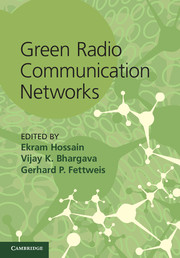Book contents
- Frontmatter
- Contents
- List of contributors
- Preface
- Part I Communication architectures and models for green radio networks
- Part II Physical communications techniques for green radio networks
- Part III Base station power-management techniques for green radio networks
- 8 Opportunistic spectrum and load management for green radio networks
- 9 Energy-saving techniques in cellular wireless base stations
- 10 Power management for base stations in a smart grid environment
- 11 Cooperative multicell processing techniques for energy-efficient cellular wireless communications
- Part IV Wireless access techniques for green radio networks
- Part V Green radio test-bed, experimental results, and standardization activities
- Index
- References
10 - Power management for base stations in a smart grid environment
from Part III - Base station power-management techniques for green radio networks
Published online by Cambridge University Press: 05 August 2012
- Frontmatter
- Contents
- List of contributors
- Preface
- Part I Communication architectures and models for green radio networks
- Part II Physical communications techniques for green radio networks
- Part III Base station power-management techniques for green radio networks
- 8 Opportunistic spectrum and load management for green radio networks
- 9 Energy-saving techniques in cellular wireless base stations
- 10 Power management for base stations in a smart grid environment
- 11 Cooperative multicell processing techniques for energy-efficient cellular wireless communications
- Part IV Wireless access techniques for green radio networks
- Part V Green radio test-bed, experimental results, and standardization activities
- Index
- References
Summary
Introduction
The overall contribution of cellular network operators to the entire human CO2 emissions is estimated at 2.5% in the US [1]. About 60% – 80% originates from wireless base stations (BSs) [2]. As current cellular network architectures are designed to cope with peak load and degraded conditions, underutilization of them occurs most of the time. A recent study [3] shows that the average power-consumption of the traditional BS amounts to nearly 850 W, with only up to 40 W power consumed to transmit from the antennas and the rest wasted even during idle operation. This result indicates that there is much room for power savings in today's cellular networks.
In this chapter, we consider the problem of power management for BSs with a renewable power source in a smart grid environment. In Section 10.2, we first provide an introduction to green wireless communications with the focus on two closely related research fields, i.e. renewable power source and smart grid. Then, we provide an overview of the power-management approaches for BS, which consists of two major directions, i.e. BS power control and smart BS operation. The former is achieved at the equipment level, while the latter can be realized at the system/network level. Afterwards, we discuss some challenges and open issues with regard to power management for BS. In Section 10.3, we present the power-consumption model for a BS. Specifically, the power-consuming components are first introduced and analyzed. Moreover, we present two power-consumption models, one for macro BSs that contain a static power-consumption part only, and the other for micro BSs that additionally consist of a dynamic power-consumption part.
Information
- Type
- Chapter
- Information
- Green Radio Communication Networks , pp. 209 - 235Publisher: Cambridge University PressPrint publication year: 2012
References
Accessibility standard: Unknown
Why this information is here
This section outlines the accessibility features of this content - including support for screen readers, full keyboard navigation and high-contrast display options. This may not be relevant for you.Accessibility Information
- 1
- Cited by
